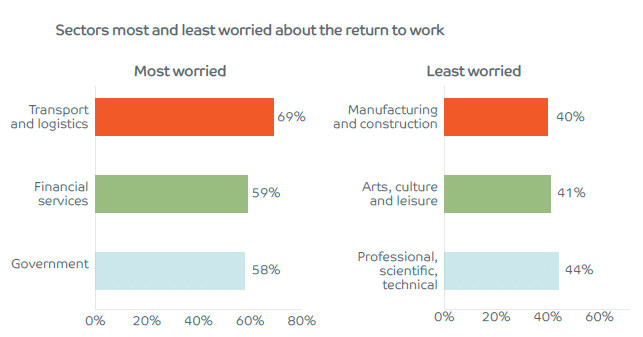With the Government announcing plans to remove almost all Covid-19 restrictions in late July, business leaders will be tasked with guiding their employees through the new normal.
While employers have a legal obligation to make the workplace Covid secure, the easing of restrictions will raise new questions about employee safety. When social distancing guidelines and the mask mandate are eased, employees will be looking to their employer for information on their new wellbeing policies.
Our recent Future of Work report asked employees how they’re feeling about the return to work and found a divide between those who are eager to get back to normal and those who are anxious about the return, so how can employers ensure the workplace is open to all?
Health anxiety is still high among employees
For employees, feeling safe is just as much a mental concern as it is a physical one. At the height of the January wave, 39% of those in manufacturing and construction were worried that their workplace still wasn’t Covid secure. And with health at the forefront of our minds, it’s not surprising that 51% of employees report anxiety around going into their place of work.

Expectations around employer support have increased, with employees recognising the benefits to their productivity as well as their overall wellbeing. Our survey found that 29% of all employees feel that their organisation’s wellbeing support has boosted their productivity, with only 6% saying their productivity has decreased.
Some sectors have seen an even bigger impact: 54% of financial services employees report increased productivity as a result of wellbeing activity.
Now more than ever, wellbeing initiatives are a simple and effective way for employers to invest in their people and boost their bottom line.
Tips for making the return to work easier
With guidelines set to change again, employees are understandably worried about the impact on their health at work. So how can employers ease the transition for those who are nervous about the return?
- Ask your people what they need to feel safe and be proactive about implementing changes as you learn. Try a return-to-work survey or schedule catch ups with managers to discuss common worries in their team.
- Are there specific groups of employees that may have different needs? For example, those shielding or those coming back from furlough may need additional support when returning to work.
- Clearly communicate the changes you’re making (or retaining) so people know what to expect, and what’s expected of them. Remember it’s important to reach everyone, including those on site or on furlough, so sending an email might not be enough.
- Consider extending flexible arrangements such as staggered start and end times and reduced office hours to provide options for those who feel less comfortable with the idea of returning to ‘normality’. You could also consider the option for employees to phase their return to the workplace, as they might after a period of absence.
- Consider introducing healthcare benefits to help your people be proactive about their health. Lunchtime exercise classes, free fruit or access to a health cash plan can all make your people feel like they’re doing something positive for their health and wellbeing, giving them a sense of control.
Supporting managers
For all but the smallest employers, managers provide a vital link between individuals and leadership teams. They’re often best placed to ask employees about their worries and report any changes in their team via catch ups and 1:1s, but they can only perform at their best if their own support needs are met.
Think of the old analogy of aeroplane masks and develop a culture of managers ‘putting on their own mask first’. Give them specific guidance to allow them to solve problems independently. This might take place in managers only sessions, designed to equip them with the knowledge and skills to support colleagues with confidence.
Remember that managers are colleagues too and they should have their own support system in place to ensure they don’t feel burdened. This could include support from Mental Health First Aiders, the HR team or a buddy system across departments.
Downloads and resources
Our favourite resources to help you put your new health and wellbeing plans into action:
The Future of Work report Download the full report for a more detailed look at how employees are feeling about the new normal.
Health and wellbeing toolkit Our free guide helps HR leaders create an effective wellbeing strategy.
Wellbeing webinars Including topics such as coping with change and work life balance.